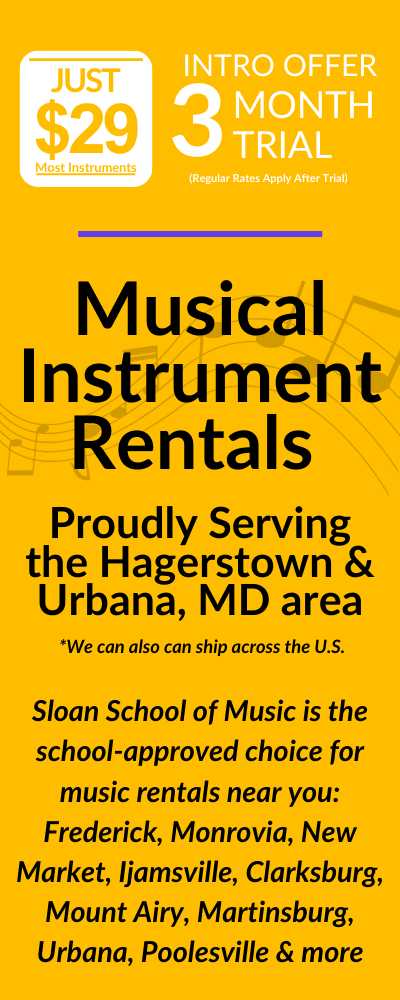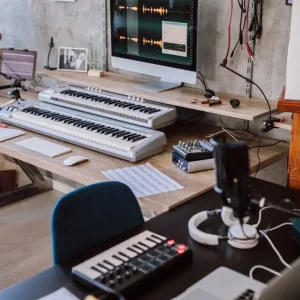Exploring the world of music production, you quickly realize the pivotal role of having top-notch gear. Whether you’re laying down tracks in a home studio or jamming out on stage, the quest for the best music equipment is universal among musicians and producers alike.
But with an ocean of options out there, how do you fish out the true gems? This adventure is more than just picking up top-notch instruments; it’s about discovering those pieces that truly click with your inner artist and boost the distinct vibe of your music.
If you’re ready to find the perfect equipment to elevate your music, explore our shop page.
Key Takeaways:
- Essential Gear: Quality equipment is fundamental for capturing and producing high-quality music.
- Beginner Setup: Start with a robust computer, a good DAW, an audio interface, studio monitors, headphones, and a MIDI controller.
- Audio Interface Choices: Choose based on connectivity, input/output capacity, and preamp quality to match your studio needs.
- Accurate Monitoring: Invest in flat-response studio monitors and headphones for precise mixing and mastering.
- Workflow Enhancement: MIDI controllers and advanced software plugins aid in intuitive music production and sound manipulation.
The Best Music Equipment for Beginners
Are you a budding music producer ready to dive into the world of music production? Whether you dream of creating the next chart-topping hit or just want to explore your musical creativity, having the right gear is essential to bringing your ideas to life.
In this beginner’s guide, we’ll walk you through the essential equipment you need to kickstart your voyage into the world of music production.
Digital Audio Workstation (DAW)
Your production setup’s beating heart is your computer. Whether you choose a Mac or PC, it’s imperative to ensure that your computer is robust enough to handle the digital audio workstation (DAW) software you intend to use.
To guarantee a seamless music production experience, seek a computer with a fast processor, ample RAM (8 GB or more is ideal), and generous storage space. You will also want to invest in some separate hard drive storage. SSD drives while more expensive are both quicker and more reliable making them ideal for music production.
Audio Interface
An audio interface is the bridge between your computer and the rest of your studio equipment. It converts analog signals from your microphones and instruments into digital signals that your computer can process.
When choosing an audio interface, consider the number of inputs and outputs you need, the type of connectivity (USB, Thunderbolt, etc.), and the preamp quality. Some popular options include the Focusrite Scarlett series and the PreSonus AudioBox series.
Studio Monitors
Studio monitors are designed to provide a flat, accurate representation of your audio, allowing you to make critical mixing and mastering decisions. Unlike consumer speakers, studio monitors prioritize clarity and transparency over bass-heavy or colored sound.
When selecting studio monitors, consider factors such as room size, frequency response, and power output. Some well-regarded options include the Yamaha HS series, KRK Rokit series, and JBL LSR series.
Headphones
A good pair of studio headphones is crucial for monitoring during recording sessions and for referencing mixes in different environments. Look for headphones with a flat frequency response, wide stereo imaging, and comfortable fit for extended use. Popular choices among producers include the Beyerdynamic DT 770 Pro, Audio-Technica ATH-M50x, and Sennheiser HD 600.
MIDI Controller
A MIDI controller allows you to play virtual instruments and control various parameters in your DAW using physical keys, pads, and knobs. While not strictly essential, a MIDI controller can greatly enhance your workflow and make the production process more intuitive and hands-on. Options range from compact 25-key controllers like the Akai MPK Mini to full-size 88-key controllers like the Native Instruments Komplete Kontrol S88.
Choosing the Best Audio Interface for Your Home Studio
The audio interface is the unsung hero of your home studio setup. It’s the critical link between your instruments, microphones, and your computer, allowing you to capture and monitor audio with pristine clarity. But with so many options on the market, how do you choose the best audio interface for your needs and budget? Let’s break it down.
Budget-Friendly Options
If you’re just starting out, you don’t need to break the bank to get a quality audio interface. The Focusrite Scarlett Solo and PreSonus AudioBox USB 96 are both excellent choices in the sub-$200 range. These interfaces offer solid build quality, good preamps, and enough inputs and outputs to handle most solo recording needs.
As your needs grow, you may want to invest in a more feature-rich interface. The Universal Audio Apollo Twin and the RME Babyface Pro are both highly regarded options in the $500-$1000 range. These interfaces offer superior sound quality, more inputs and outputs, and advanced features like DSP processing and expandability.
High-End Audio Interfaces
For professional-level recording and production, you’ll want to look at high-end interfaces like the Universal Audio Apollo x8p or the Antelope Audio Orion Studio Synergy Core. These top-of-the-line interfaces boast premium preamps, extensive I/O, and cutting-edge features like networked audio and Thunderbolt 3 connectivity. They’re a serious investment, but they deliver uncompromising performance for the most demanding studio applications.
Top Studio Monitor Picks for Accurate Mixing
Your studio monitors are your windows into the true sound of your mixes. They’re the key to making critical decisions about balance, EQ, and dynamics. But with countless options available at every price point, it can be tough to know where to start. Here are our top picks for studio monitors at every level.
If you’re just starting, the PreSonus Eris E3.5 and JBL 305P MkII are both excellent choices in the sub-$200 range. These compact monitors offer impressive sound quality and accuracy for their size and price. They’re perfect for small home studios or producers on a tight budget.
Mid-Range Studio Monitors
As you progress in your production journey, you may want to upgrade to a more refined set of monitors. The Adam Audio T7V and the Yamaha HS8 are both highly regarded options in the $500-$1000 range. These monitors offer a larger sweet spot, more extended low end, and greater detail and clarity across the frequency spectrum.
High-End Studio Monitors
For professional-level mixing and mastering, you’ll want to invest in a pair of high-end studio monitors like the Focal Solo6 Be or the Genelec 8341A. These top-tier monitors deliver unparalleled sound quality, with ultra-precise imaging, exceptional transient response, and ruler-flat frequency response. They’re a significant investment, but they’re essential tools for critical listening and decision-making in a professional studio environment.
MIDI Controllers to Enhance Your Music Production Workflow
While you can certainly produce music using just a mouse and keyboard, a MIDI controller can take your workflow to the next level. These versatile devices allow you to play virtual instruments, control parameters, and trigger samples with the expressiveness and tactile feedback of physical keys, pads, and knobs.
If you’re always on the go or have limited desk space, a portable MIDI controller like the Akai MPK Mini or the Arturia MiniLab MkII can be a game-changer. These compact controllers pack a lot of functionality into a small footprint, with 25 mini keys, 8 pads, and a handful of knobs and buttons. They’re perfect for sketching out ideas on the road or for producers who prefer a minimalist setup.
Full-Size MIDI Keyboards
For more serious playing and recording, a full-size MIDI keyboard is a must-have. The Native Instruments Komplete Kontrol S49 and the Novation Launchkey 49 are both excellent choices in the 49-key range. These controllers offer semi-weighted keys for a more piano-like feel, as well as a wide array of pads, knobs, and faders for controlling your virtual instruments and DAW.
MIDI Pad Controllers
If your focus is on beat-making and finger-drumming, a dedicated MIDI pad controller like the Akai MPC Live II or the Ableton Push 2 can be a powerful addition to your setup. These controllers offer a grid of velocity-sensitive pads, as well as a range of other controls for sequencing, sampling, and live performance. They’re designed to integrate seamlessly with specific DAWs and workflows, providing a hands-on, hardware-like experience for electronic music production.
Microphone Essentials for Recording Vocals and Instruments
A great microphone is the foundation of any professional recording setup. Whether you’re tracking vocals, acoustic guitars, or drum kits, the right mic can make all the difference in capturing the nuance and character of your sound.
Large-diaphragm condenser mics are the go-to choice for studio vocal recording. They offer exceptional detail, clarity, and sensitivity, making them ideal for capturing the subtleties of the human voice. Some classic options include the Neumann U87, the AKG C414, and the Rode NT1-A. These mics are versatile enough to handle a wide range of vocal styles and genres.
Small-Diaphragm Condenser Microphones
Small-diaphragm condenser mics, also known as pencil mics, are great for recording acoustic instruments like guitars, strings, and percussion. They offer a fast transient response and a detailed, natural sound. Popular options include the Shure SM81, the Neumann KM 184, and the AKG C451 B. These mics are often used in pairs for stereo recording techniques.
Dynamic Microphones
Dynamic mics are the workhorses of the recording world. They’re rugged, reliable, and can handle high sound pressure levels, making them ideal for recording loud sources like guitar amps and drums. The Shure SM57 is an industry-standard choice for snare drums and guitar cabs, while the Shure SM7B is a popular choice for broadcast and podcast vocals. Dynamic mics are also great for live performance and touring.
Software and Plugins to Expand Your Creative Possibilities
While hardware is the foundation of your studio setup, software and plugins are the tools that allow you to shape and manipulate your sound in endless ways. From virtual instruments to effects processors, these digital tools are essential for modern music production.
Virtual instruments, or softsynths, are software emulations of classic synthesizers, samplers, and other electronic instruments. They allow you to create and play a vast array of sounds without the need for physical hardware.
Some popular options include Native Instruments Massive, Xfer Records Serum, and Spectrasonics Omnisphere. These powerful synths offer deep sound design possibilities and extensive preset libraries.
Effects Plugins
Effects plugins are used to process and manipulate audio in various ways, from basic EQ and compression to complex modulation and time-based effects. Some essential effects include reverb, delay, chorus, and distortion. Popular plugin bundles like Waves Gold and FabFilter Total Bundle offer a wide range of high-quality effects for mixing and mastering.
Mixing and Mastering Tools
Specialized mixing and mastering plugins are designed to help you achieve professional-sounding results in the final stages of production. These tools include EQs, compressors, limiters, and stereo-imaging processors.
Some popular options include the iZotope Ozone mastering suite, the FabFilter Pro-Q 3 EQ, and the Waves SSL G-Master Buss Compressor. These plugins offer advanced features and algorithms for polishing your tracks to perfection.
Optimizing Your Studio Space for Better Sound
While having the right gear is important, the acoustic properties of your studio space can have a huge impact on the quality of your recordings and mixes. Untreated rooms can introduce unwanted reflections, resonances, and frequency imbalances that can make it difficult to achieve accurate and professional-sounding results. Let’s explore some key tools and techniques for optimizing your studio space.
Acoustic panels are designed to absorb sound reflections and reduce reverberation in your room. They’re typically made of high-density foam or fiberglass and can be mounted on walls and ceilings to control the acoustic properties of your space. Brands like Auralex and GIK Acoustics offer a wide range of acoustic panels in various sizes, shapes, and colors to suit different room types and aesthetic preferences.
Bass Traps
Bass traps are specialized acoustic treatments designed to absorb low-frequency energy and reduce standing waves in your room. They’re typically placed in corners and along walls to tame bass buildup and improve the overall clarity and tightness of your low end. Popular options include the Auralex LENRD Bass Traps and the GIK Acoustics Monster Bass Traps.
Diffusers
Diffusers are used to scatter sound reflections in a controlled way, helping to create a more even and natural-sounding acoustic environment. They’re typically placed on rear walls and ceilings to enhance the sense of space and depth in your room. Brands like RPG Acoustics and Primacoustic offer a range of diffuser designs, from simple poly cylindrical shapes to more complex quadratic residue diffusers.
By combining these acoustic treatment elements in a balanced way, you can create a studio space that sounds great and inspires your best work. Whether you’re working in a dedicated room or a converted bedroom, paying attention to the acoustics of your environment is essential for achieving professional-quality results.
Find The Best Music Equipment at Sloan School of Music
In wrapping up our sonic exploration, remember this – while chasing after the best music equipment might seem like seeking a needle in a haystack at times, what truly matters is aligning your choices with your musical vision.
The landscape of audio gear is vast and varied but armed with knowledge and discernment, navigating it becomes less daunting. It’s not merely about owning gadgets; it’s about empowering yourself to create sounds that stir souls.
Your toolkit – be it packed with vintage icons or cutting-edge tech – should serve as an extension of your creativity. To check all that we offer, contact Sloan School of Music today!











